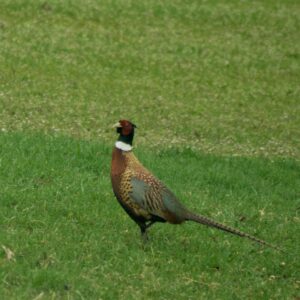Ring Necked Pheasants down but not out
article and photo by Rose Collison
Mornings, readers’ ears may be treated to the distinctive cackle of a ring-necked pheasant making its presence known. Because ring-necks nest on the ground and don’t tend to roost in trees at night, they and their fledglings are vulnerable to fox and dreaded coyotes.
Ring-necked pheasants, native to China and East Asia, have been successfully introduced in other parts of the world, including North America, and specifically here in the Stockbridge area. Males are vibrantly colored with blue-green heads, red face wattles, and distinctive white neck rings. Females and youth are plain brown.
Pheasants along with most members of the grouse family, have specialized, powerful breast muscles–the white meat found on a chicken. These muscles deliver bursts of power that allow the birds to escape trouble in a hurry, flushing nearly vertically into the air and reaching speeds of nearly 40 miles per hour. While birds normally don’t fly more than 600 feet at a time, strong winds can extend their flight considerably.
Because they live in tall vegetation and old fields, ring-necked pheasants can be hard to spot even in places where they are abundant. Keep an eye out for them running between patches of cover as you travel through agricultural areas, particularly along dirt roads where the birds often forage in weedy areas.
Since they don’t migrate south, winter is a good time to look for ring-necked pheasants. Vegetation is minimal then, crops have been harvested, and some areas have a snowy backdrop for the birds to stand out. In spring and summer, listen and watch for males performing their calling and wing-flapping display in open areas.



